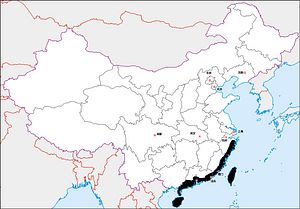This article series explores 12 distinct “regions” within China: six “core” regions long dominated by the majority Han ethnic group and six “periphery” regions home to many of China’s ethnic minorities. The series overview is available here. To view the full series, click here.
Walled off from the interior by mountains, the river deltas and natural harbors along the coasts of Zhejiang, Fujian, and Guangdong nurtured seafaring and trade-oriented people. This was the last region whose inhabitants, the “hundred tribes of Yue,” were assimilated into the Han ethnicity; related groups developed distinct identities as the Vietnamese and various minorities of China’s southwest. The southeast coast’s dialects are the most archaic of the modern Chinese language family, and its people sometimes seem to be regarded (facetiously) by northerners as barely “Chinese.” They are famous nationally for their industry and for being willing to eat “anything with four legs except a table.”
Facing out to maritime Asia, this region dominated China’s foreign trade before the Opium Wars, and was the chief source of Chinese emigration; before the 1990s, almost all the 50-plus million Chinese diaspora originated from Guangdong and Fujian provinces. With China’s disintegration in 1911, Guangdong became the base of the Nationalist Party (KMT), which nominally reunited most of the country in the late 1920s. The neighboring British colony of Hong Kong was largely insulated from China’s post-World War II vicissitudes, developing into a world-leading port and financial center.
The large offshore islands of Hainan and Taiwan both received large numbers of Han settlers from the 1500s (Hainan’s aboriginals are descendants of the ancient Yue, while Taiwan’s are Malayo-Polynesian). Being on the typhoon-lashed fringe of the “civilized” world, Hainan was a frequent banishment posting for the losers in Chinese officialdom’s factional struggles. Taiwan was in the 1600s briefly colonized by the Dutch and then ruled by a regime of Ming dynasty loyalists, soon crushed by the mainland’s new Qing dynasty. From 1895 to 1945 the island was a colony of Japan, and in 1949 the KMT government fled there after defeat in the Chinese Civil War. Today this region is sometimes collectively called “greater China” (given the unique statuses of Taiwan, Hong Kong, and Macau), due to the dense economic and cultural links between its parts.
Guangdong’s Pearl River delta, now an urban sprawl of over 40 million people dominated by the cities of Guangzhou, Shenzhen, and Hong Kong, is the heart of China’s export manufacturing sector. Returned to China in 1997, Hong Kong retains a unique role as a financial hub and investment gateway, while Shenzhen has evolved over three decades from a fishing village into “the Silicon Valley of hardware.” Firms headquartered here include Tencent, the internet giant that in 2016 joined the world’s top ten companies by market capitalization; DJI, the world’s largest commercial drone manufacturer; and Huawei, the world’s largest telecom equipment maker and third largest smartphone maker. The former Portuguese colony of Macau is the world’s leading gambling center by revenue.
The People’s Liberation Army’s Southern Theater Command is headquartered in Guangzhou, with responsibilities including the border with Vietnam and the South China Sea. Homeported at Zhanjiang down the coast is the PLA Navy’s South Sea Fleet, which has recently been prioritized in receiving new vessels. Hainan hosts the nation’s newest space launch center at Wenchang and an underground submarine base within swimming distance of China’s biggest resort town, the probable homeport of the PLAN’s nuclear ballistic missile submarines.
Until recently, the Cantonese of Guangdong were seen as the typical “Chinese” in Anglosphere countries, given the oldest Chinese communities in North America and Australia originated from here, and the cultural influence of Hong Kong. But in Taiwan and across Southeast Asia, the dominant Chinese groups are the Hokkiens (Fujianese), followed by the Teochew (from Chaozhou prefecture in Guangdong), and the Hakka (from the highlands of Guangdong and Fujian). The Hakka, a “latecomer” group occupying marginal lands, have produced an outsized share of political leaders including Sun Yat-sen, Lee Teng-hui in Taiwan, and Lee Kuan Yew in Singapore, not to mention the messiah of the Taiping rebellion.
Ethnic Chinese of this regional origin still dominate the private sector of every Southeast Asian economy, except Brunei and possibly Vietnam (where they are making a comeback from the expropriations of the 1970s). Southeast Asian political leaders with Chinese ancestry include Ne Win of Myanmar, and the “opium king” Khun Sa; Thailand’s royal house and the Shinawatra family; Hun Sen of Cambodia; every president of the Philippines, including Rodrigo Duterte; and all of Singapore’s prime ministers.
Next up: China’s periphery regions.
John Lee is a former visiting fellow of the Mercator Institute for China Studies. He tweets at @J_B_C16.

































